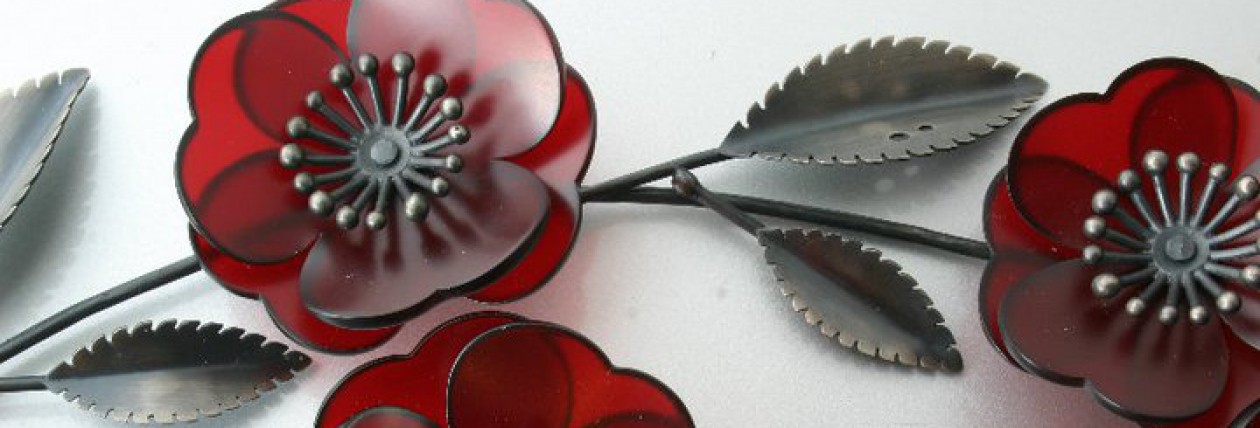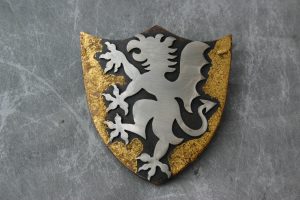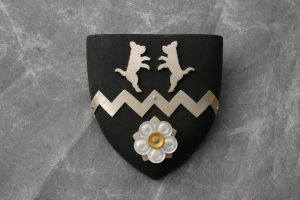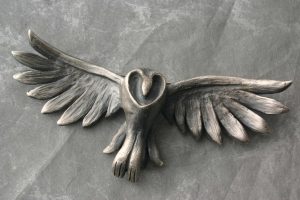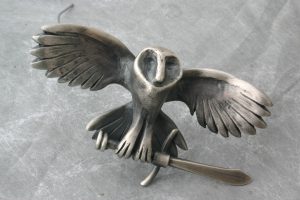bronze/silver/gold leaf
Monthly Archives: August 2016
El Perrito’s Coat of Arms
The tincture, or background colour of the Coat of Arms of El Perrito the Alhambra Chihuahua is sable, representing constancy and grief, constancy for his loyalty and grief both for his lost eye and his Techichi friends.
Two chihuahua face each other in a saltant attitude. Below this runs a dancette line in silver. This represents water and the long journey El Perrito made across the sea to reach Spain. The escutcheon is filled by a strawberry flower, which in heraldry symbolises hope and joy.
Heraldry of El Perrito, tawa/silver/mother-of-pearl/fine gold
Heraldic Owl brooch
Simon de la Choutte, or the Owl and Falchion
Simon de la Chouette, Mercenary and self-styled Assassin.
Simon de la Chouette was born in Dijon, Bourgogne on the same day of the same year that Otto I Count of Burgundy was assassinated, January 13, 1200AD. The two events are not related…
owl & falchion, silver
His background was modest, distantly noble, and his surfeit of brothers determined his fate early. He was marked out as chaff for the crusader cause, and so began early training in the arts of war. He was sent to live with a more financially salubrious branch of the Chouette family; a first cousin was closely aligned with Duke of Burgundy Odo III via an advantageous marriage, so young Simon was sent at age six to reside with his cousins in order to begin training, initially as a page, and with luck eventually as a squire if he showed aptitude.
Young Simon showed aptitude aplenty. He was a natural horseman, a knife-wielding demon with a sword and dagger, and he exhibited exactly the correct degree of contemptuous deference to his noble betters at court to win him the admiration of the plotters and conspirators. In short, he was well on track to a squirehood. As a young knight’s squire, his tasks included caring for his master’s horse, maintaining his weapons and armoury, and generally tending to the requirements of his liege. Simon’s burning ambition was to attain knighthood…
His opportunity arose on July 27 1214 at the battle of Bouvines which ended the 1202-1214 Anglo-French War.
Simon’s knight was a Sir Geoffrey de Mountfort. Over-sized, over-loud and overly self-entitled he rampaged ineffectually about the battlefield on his warhorse, a huge black beast festooned in penants, that nevertheless still strained under the enormous bulk of Sir Geoffrey, a man made soft by the pleasures of the Burgundian court. A wencher, a glutton, and a boozer, he was a man somewhat under the weather on July 27 1214. He had spent the previous evening frotting, rutting, and over-indulging in a local whorehouse and consequently could barely climb onto his warhorse let alone sit astride it.
He slumped in the saddle like a sack of rotting onions, and a green bile was seen by Simon to issue glutinously from the corner of his mouth. Simon stayed loyally and perilously close to Sir Geoffrey; the stench emanating from the dissolute knight was enough to fell a polecat. He cared not one whit for the life of his obese mentor; he wanted only to win his knightly spurs and accolades for bravery. The battle was fierce and savage. Axes were hefted and hot blood spurted from severed arteries. The ground was rendered slippery with steaming viscera. The stench of fear, shit, and death was pervasive. Young Simon kept his wits where Sir Geoffrey failed. He spied a huge poleaxe wielding man about to cleave a fatal furrow into the skull of his knight errant. Sir Geoffrey teetered helpless and cross-eyed in the saddle whilst Simon slithered in behind the giant, and with a deft slash sliced both his achilles tendons with his falchion, a savage knife, and a weapon of choice for any would-be assassin. Sir Geoffrey survived and Simon de la Chouette was recommended his knight’s spurs and accolades. Bouvines was a decisive victory for the French coalition. It led to the drafting of the Magna Carta, but that is another story…
Simon spent the next decade honing his skills as squire for hire. His knife prowess was exemplary; politically he kept his ear to the ground. If a plot was unfolding, Simon would re-wrap it and deal to the would-be perpetrators at the behest of his paying masters. He would have done it for free and for practise; pieces of silver were merely a bonus. He was a confidante of Odo III and his sucessor Hugh IV.
He was ofttimes called upon to solve the problem of worthless siblings who were at risk of inheritance. So often in mediaeval Burgundy siblings would meet with unfortunate hunting accidents, thereby solving the problem of undeserved primogeniture. . So often Simon was in the vicinity of the tragedy. In this way Hugh the Deformed, Robert the Devious and Otto the Witless were all prevented from doing irreparable damage to the kingdom. Any luckless soul who heard the cry of the owl in daylight hours was almost certain to find himself on the wrong end of a sharpened dagger, with young Simon on the favourable end. He drew the line at the killing of women however; chivalry was not yet fully dead.
At age 21 he was knighted, and in 1228 he embarked upon his greatest adventure yet- the sixth crusade to the Holy Land. He did not believe in a God, Christian or otherwise. He believed in killing those who did not willingly capitulate. This is always a potential problem for those who have been taught the dubious art of murder since the tender age of six. He voluteered to join the Order of the Teutonic Knights; a mercenary order originally formed in Palestine to establish hospitals and aid Christians on their pilgrimage to the Holy Land.
Alas for Simon, there was very little fighting to be had on the 6th Crusade. It was mainly a diplomatic mission for Frederick II, Holy Roman Emporer who had a claim to the Kingdom of Jerusalem through marriage. Frederick managed to cleave off some territory but essentially failed to recover any of the desirable holdings. Consequently the Muslims retained control over the Temple Mount, the al-Aqsa Mosque and the Dome of the Rock, and blood was not shed. Simon was disappointed to the verge of frustration. He cursed his naievety- why had he not joined the Albigensian Crusades instead? He could have been slaughtering Cathars on his own metaphorical doorstep instead of twiddling his blood-hungry thumbs in a sand-infested heathen hellhole.
Bidding farewell to his brothers in arms with nary a backwards glance he opted to head back to Burgundy via Persia and Syria.
It is precisely here that we lose Simon de la Chouette for a number of years. Scholarship is divided on what happened in the intervening period before we pick up with Simon again in 1238…
Numerous students of mediaeval crusade history have tried to account for Simon’s missing years. He is now an unpopular subject for dissertation because everything relating to this time is speculation. Please bear with me as I add to the general cacophony of conjectural scholarship.
It’s my belief that Simon headed North into Syria, and whether by accident or design happened upon a remnant of the notorious Nizari Sect, the infamous assassins active in Syria and Persia during the early crusades. It is likely he became a convert to Islam, not because he was a Mohammedan myrmidon, but because he wanted access to the esoteric knowledge of the Nizari…
Simon finally reappeared in Dijon, Burgundy in 1238. He was scarcely recognisable; a swarthy, bearded, sinewy apparition, and weathered, as you would expect of a man who had spent the past decade in the desert, only now he eschewed the excellent jambon persille with mustard, a Dijon speciality, and no fine Burgundian wine was seen to ever pass his lips. After ten years spent learning how to cut the throats of others with aplomb, he seemed to have culinarily slit his own…
He was soon back in the employ of the Burgundian Duchy, who were initially perplexed by Simon’s new austerity but appreciative of his murderous finesse and wit.
One unfortunate death that resulted in no end of sniggering in the private chambers of Hugh IV was that of a hapless usurer about to be wed who had taken advantage of the gambling habits of too many of the Duke’s favoured knights. As he awaited his bride on the forecourt of Dijon’s Notre Dame he was crushed by a falling stone gargoyle that plummeted suddenly and inexplicably from the gargoyle encrusted facade of the church. The hysterically caterwauling bride was removed, and closer inspection of the scene revealed that the moneylender had been crushed by a gargoyle representation of a usurer, a vicious and much remarked upon irony indeed. Hugh IV solicitously had all the other gargoyles removed from the church lest another horrible accident befall some innocent, and Simon received his customary payment in pieces of silver.
A little remembered son of Dijon, Simon de la Chouette is nevertheless commemorated in a modest way by a carved owl on the corner of a buttress on the north side of the chapel of Notre Dame. Almost all the features of the owl are obliterated; rubbed bare by countless hands over eight centuries, it is believed to be a lucky charm, and a symbol of Dijon. It seems fitting to me that a man who was so shadowy and intangible in life should be represented by a featureless namesake. There was also a fifteenth century public house in an unsalubrious part of London called The Owl and Falcon, now long since burned down in the Great Fire. It is thought that this may reference Simon de la Chouette also, falcon being a pun on falchion, the savage dagger that was Simon’s favoured weapon.
If visiting Dijon, I recommend a visit to Notre Dame. All the gargoyles were replaced in the nineteenth century, and though they are purely decorative rather than functional, they are quite spectacular grotesques. Be sure to pat the little carved owl by the chapel too….
